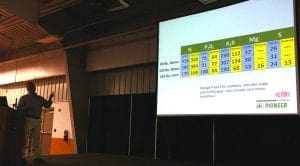 (HARRINGTON, DELAWARE) – January 12, 2017 – When Dan Arkels goes for high yields from his soybeans, he leaves no stone unturned. Everything he can think of gets scrutinized and optimized. And recorded to compare for next year.
(HARRINGTON, DELAWARE) – January 12, 2017 – When Dan Arkels goes for high yields from his soybeans, he leaves no stone unturned. Everything he can think of gets scrutinized and optimized. And recorded to compare for next year.
Arkels, of Peru, Ill., grew 104 bushels of soybeans per acre in 2014, becoming the first verified 100-plus bushel grower in that state. His current goal is 150 bushels.
Arkels spoke at Agronomy Day Jan. 12, 2017 at Delaware Ag Week in Harrington, reminding soybean farmers there that an incredible number of variables come into play when soybeans are grown. His appearance was sponsored by the Delaware Soybean Board, the farmer-directed board funded through the soybean checkoff program.
Variety selection? Look for big leaves, to capture more light, he says. Disease suppression? Plant into fields that have been in corn for two or three years. Timing? Get them in early – leave the corn planter to get beans in, he advises. He goes for 15-inch rows, planting 180-182,000 seeds for a stand of 165-175,000 plants per acre. “I’m thinking of dialing that back some, though,” he added. “I want to allow the plants room to branch.”
His current favorite seed is Pioneer T series, which he says provides good emergence and early growth, a shorter, branched plant, cyst resistance, sudden death and brown stem tolerance and “seed flex” – the plant will increase the seed size, given favorable conditions.
Seed treatments? Yes. And he scouts all season and treats as needed to maintain plant health. Aerial applications of nutrients and plant health protection begin at R2 and continue every 14 days through R6. Biologics encourage flowering and retention of flowers. Fungicide goes on at the end of the season, to extend pod fill. Fertility plans begin with a soil test weekly tissue samples tell him if he’s in range.
Delaware farmers plant about 180,000 acres of soybeans each year, and the crop generates approximately $60 million in value to the state. Delaware’s agricultural industry contributes about $8 billion per year to the Delaware economy.
The soybean checkoff assesses one-half of one percent of the net market value of soybeans at their first point of sale for research, education and promotion activities. One-half of the soybean checkoff assessments collected by the state boards like the Delaware Soybean Board are forwarded to the United Soybean Board for national and international projects.
###
